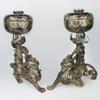Global Tour of Ethnographic Arts Featured on The Curator’s Eye
- NEW YORK, New York
- /
- May 08, 2013
In conjunction with the upcoming African, Oceanic, Native American, and Pre-Columbian sales and shows, The Curator’s Eye (www.CuratorsEye.com) turns its spotlight to the exceptional Ethnographic Arts currently on display on the continuous online exhibition. The Curator’s Eye offers an around-the-world tour of rare, distinguished collectible objects from Borneo to Alaska and places in between.
Tlingit Fighting Knife
The global tour of noteworthy items begins on the Northwest Coast of America, with a rare Tlingit file-blade knife. This fighting knife marries a sensitively carved bear on the pommel with a very sharp blade that was forged from an old file from the late 1880s. The Tlingit were the preeminent metalworkers of the Northwest Coast, working both with native copper and with copper and iron obtained through trade.
Okvik Harpoon Counterweight
Joining the knife is an Okvik harpoon counterweight with extensive engraved decoration suggesting birds’ heads. This ivory winged object, dated between 250 B.C. and 700 A.D., is an excellent example of the hunting implements of the Old Bering Sea cultures. Most of the front retains the natural light color of the original ivory, which highlights the decorative detail.
Kwakiutl Thunderbird Mask
Rounding out the items from the Pacific Northwest is a Kwakiutl Thunderbird mask in original paint, dated between 1890 and 1910. This boldly painted mask has a bird with an articulated beak sitting at the top; this smaller bird was probably a clan symbol of the wearer. Kwakiutl masks were used in extensive winter ceremonies. An intricate system of intellectual property rights governed the use of symbols in the masks, and who was permitted to wear and dance the mask.
Zuni Pueblo Bolo Tie by Leo Poblano
Continuing south, a bolo tie in the form of a thunderbird with channel inlay by Leo Poblano joins the group. Leo Poblano was born about 1905 at Zuni Pueblo. Active as a jeweler between 1919-1959, he had an exceptional talent for inlay jewelry. This item is one of the most unusual wing treatments and more reminiscent of an archangel than a thunderbird. In contrast to the organic supple forms of the large wings, the head, lower body and tail are rendered using explosive traditional geometric patterns and bright colors. Noted for his large inlay figures, many of Poblano’s masterpieces were preserved by C. G. Wallace. His work is in the permanent collections of the Smithsonian Institution, among other collections.
Chancay Loin Cloth
Originating from the Chancay culture in Peru is a triangle-shaped textile loincloth from circa 800 to 1200 A.D. This beautiful slit weave, gold-colored panel is woven with profile birds within triangular border and has a red fringe around. It also displays long figural decorative panels with a split tassel, each with a frontal figure.
Papua New Guinea Ancestor Figure
Crossing the Pacific to Oceania, a male ancestor figure from Papua New Guinea joins the items on display. From Lower Sepik, this 19th century carving stands on wedge-shaped feet with attenuated arms, and its broad pectorals are deeply incised with ritual scarification motifs both on its front and back. The large oval head and expressive face projects great pathos. The dark brown patina is very fine. Indeed, large figures of this quality are not easily found on the market today.
Borneo Dance Mask
A ‘Hudoq’ mask from Dayak, Borneo continues the selection of items from around the world. This 19th century example is a surreal work of art; the human face is brilliantly undergoing a metamorphosis into a crocodile. The teeth are finely delineated and menacing. Important to note here is the beautiful design under the nose that produces a curl of negative space. The archaic nature of this mask, as well as the overall quality suggests great age, which is evident in the deep patina and fine adze work.
Indian Bronze Bhuta Mask
Another mask, this one from Kerala, South India, joins the above. Cast from bronze and representing the boar-headed avatar of Vishnu, this festival mask displays raised brows, bulging eyes with circular pupils, elongated snout with two pierced circular nostrils, protruding tongue, and rows of sharp pointy teeth and bared fangs, wearing circular ear ornaments encircled by a band of cobras interspersed with tapering finials. The present example, circa 17th to 18th century, is a representation of one of the popular spirit deities, known as bhuta masks are represented with an aureole of raised cobra hoods, which signifies the power and importance of the deity.
Bwami Society Masquette
The global ethnographic journey is wrapped up by an elegant camel-colored masquette from the Bwami Society, of the Lega Tribe in the Democratic Republic of the Congo. Traditionally used as an initiation object, this beautiful lukwakongo-style masquette, made circa 1900-1910, would have been hung using fiber or twine to a latticed structure which would have been on display during Bwami society ceremonies and rituals, to either teach a proverb or convey another important message for Bwami initiates. The mask has a polished, rich, caramel-colored patina that reflects many years of handling. The holes for what was once a fibrous beard have been bored out with a hot metal tool, consistent with the tradition of creating mask holes in the DRC.
The Curator’s Eye is the distinctive online platform for the finest art and antiques from distinguished dealers around the world. To view more exceptional ethnographic items from cultures across the globe, visit www.CuratorsEye.com.
Contact:
Leah TharpeThe Curator's Eye, LLC
8885995099
leah.tharpe@curatorseye.com
CuratorsEye@gmail.com
888-599-5099
http://www.curatorseye.com
About The Curator's Eye, LLC
A scholarly online exhibition connecting museums, collectors, and dealers with the finest art and antiques available on the market.












100x100_c.jpg)



